HISTORICAL MINIATURES JOURNAL ISSUE NUMBER 13
PUBLISHED BY GEORGE GRASSE
|
PHOTO TOUR
OF APPOMATTOX COURT HOUSE AND VILLAGE 1865 |
By George Grasse
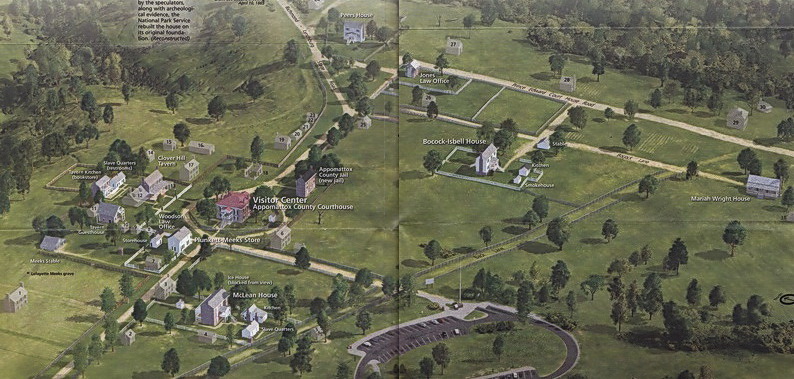 |
|
#1: This is illustration taken from the Appomattox
Court House National Historic Park brochure showing the main reconstructed
features of the village. The Park's Visitor Center is located in the
reconstructed Court House with the red roof. The reconstructed McLean
"Surrender House" is directly below it close to the visitor's parking lot.
Most of the buildings in this view are no longer standing and are shown in faded
gray colors. The main road running through the village loops around the
courthouse. This is the Richmond-Lynchburg Stage Road with Richmond (east)
off to the top center and Lynchburg (west) to the lower left.
North runs roughly parallel to the Prince Edward Court House Road at the top.
|
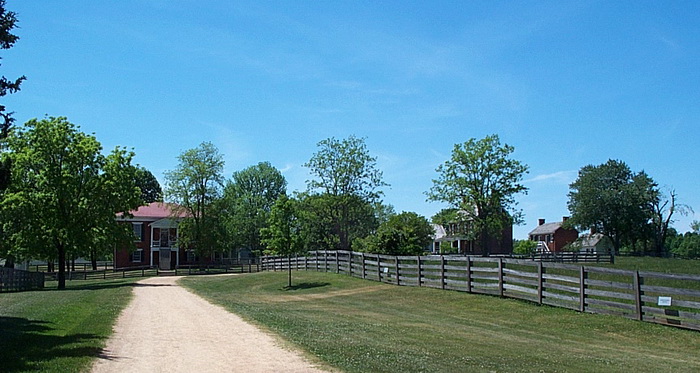 |
|
#2: Appomattox County Court House east side from the
Richmond-Lynchburg Stage Road looking west. My photo tour begins
here and just off to the right where the fence sign is posted is the site of the
remains of building 19, the W. Rosser Tenant House.
The Court House straight ahead was the "raison d'etre" for the Appomattox
Village site. It is a
reconstructed building approved for construction in the newly designated
Appomattox Court House National Historical Park. Off to the right
partially hidden by a large oak tree is the Clover Hill Tavern. To its
right is the Tavern's kitchen and the white-washed Slave Quarters. |
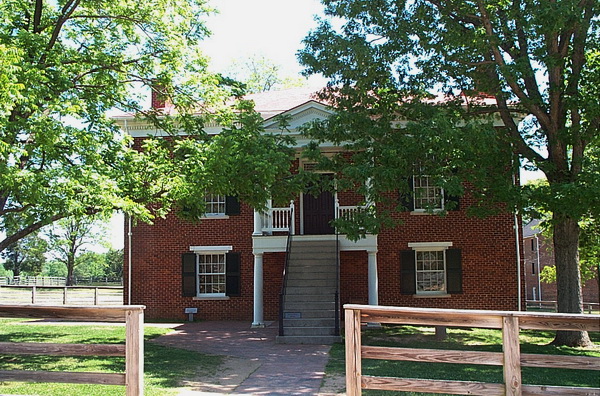 |
|
#3: Close up of the east entrance off the
Richmond-Lynchburg Stage Road. The reconstructed court house serves as the
Park's Visitor Center. There are guided tours every so often plus you
might run into an American Civil War interpreter in costume. |
 |
|
#4: Turning right at the Court House and following
the loop, all of the buildings on the right are the Clover Hill Tavern complex.
The Tavern is the prominent brick building. To its left is the Tavern's
Guest House. To the rear of the Tavern are the Kitchen (left rear mostly
obscured in this photo and the Slave Quarters. Between the Tavern and the
Guest House stood the Dining Room marked building 12 on the map. |
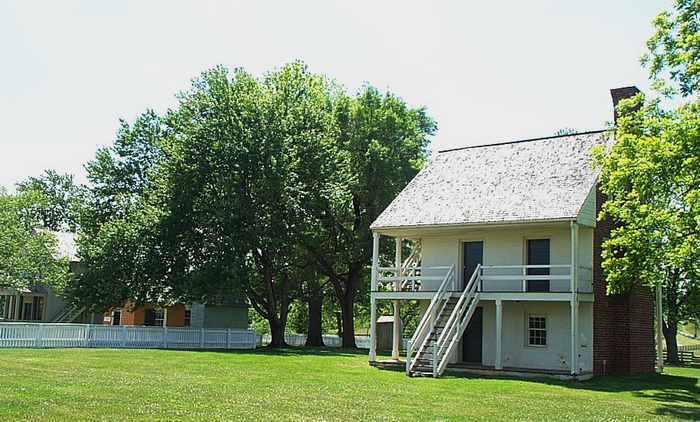 |
|
#5: This is a close up of the Clover Hill Tavern
Guest House with rooms on two levels. In the background far left is the
Plunkett-Meeks Store, the "orange" Woodson Law Office, and the Plunkett-Meeks
Storehouse. |
 |
|
#6: Behind the Clover Hill Tavern is the Kitchen
(left) and the Slave Quarters (right). The kitchen serves as the Park's
Bookstore. Because of the great potential for open fires, kitchens in
large workplaces and homes were detached, in this case about 100 feet away from
the Tavern proper. Food was brought to the Dining Room (no longer
standing) and placed in a "warming" kitchen" until served to guests. |
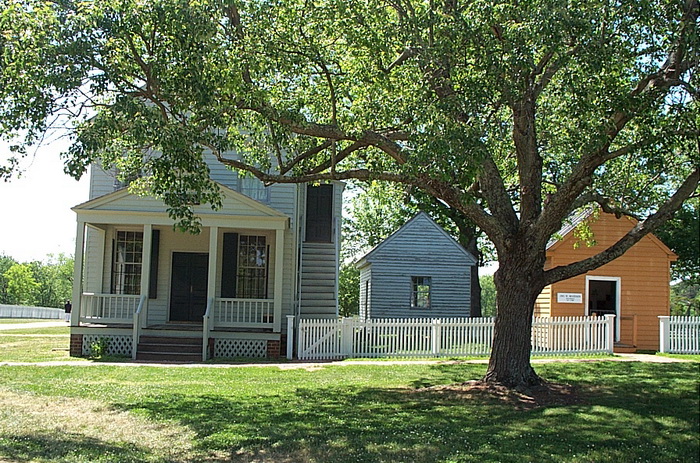 |
|
#7: This photo was taken in front of the Clover Hill Tavern Guest House
looking west. At the far left along the white picket fence runs the
Richmond-Lynchburg Stage Road after completing its loop around the Appomattox
Court House. On the left stands the Plunkett-Meeks Store. On the far
right stands the "orange" Woodson Law Office. In between and set back
about 40 feet is the Plunkett-Meeks Storehouse. |
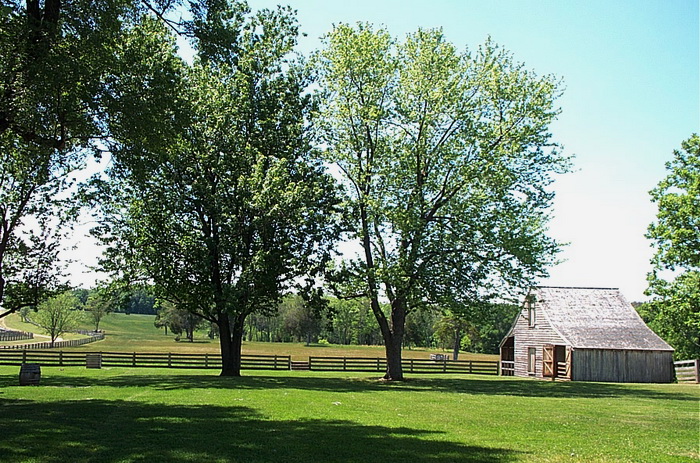 |
|
#8: Stepping between the Store and the Law Office
and just beyond the Storehouse is this photo of the Meeks Stable. In the
vacant field beyond the fence line and to the right of the Richmond-Lynchburg
Stage Road once stood the Union Academy Dwelling House, marked building 1 on the
map. We are now west of the Appomattox Court House. |
 |
|
#9: Walking back between the Store and the Law
Office and moving to the road, this is a view west on the Richmond-Lynchburg
Stage Road out of the village with the edge of the store on the right and the
McLean House with outbuildings on the left. |
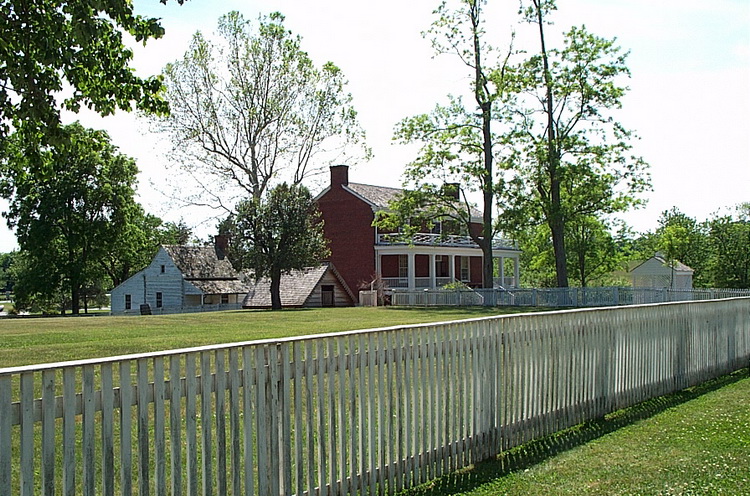 |
|
#10: Walking across the road a a little towards the
McLean House, more outbuildings can be seen. All of them including the
house were reconstructed from photographs and the dismantled remains of the
original buildings. The detached kitchen is on the left. The smaller
structure to its right is the ice house. From the nearby Appomattox River,
ice formed during winter being the southern-most locale for ice-forming.
Residents would saw chunks of ice from the river, transport them back to their
home, and, in this case, store the ice in a large pit covered by the structure
you see. The depth and width of the pit was calculated to hold enough ice
to last until the next season. The small building on the right appears to
have been used to cover the well or as a front garden gazebo or both. On
the front of the McLean property abutting the road and just off to the right,
once stood the non-disappeared Raine Tavern was remained empty since 1865 and
withered away some time after that. |
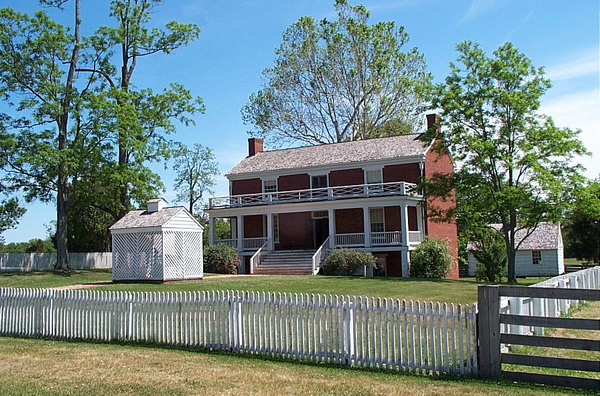 |
|
#11: Walking west along the Richmond-Lynchburg Stage
Road and just past the entrance to the McLean House is the spot where this photo
was taken. The building in the right rear is a reproduction of the Slave
Quarters. |
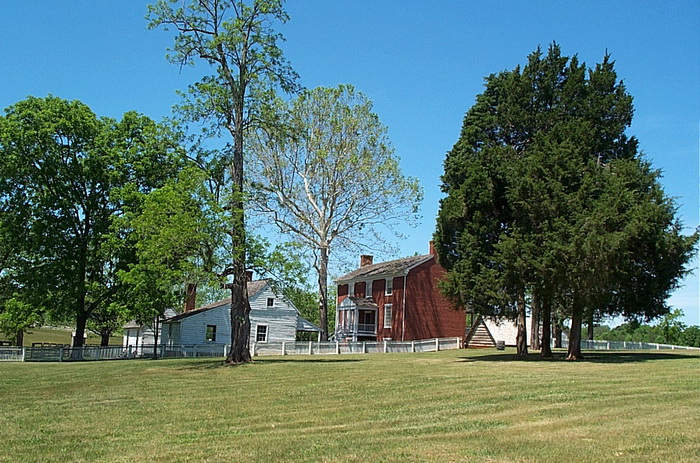 |
|
#12: This is a view of the McLean House from the west
side along the Park's parking lot lane. The Court House would be slightly
behind but well to the right and off camera. From left to right can be
seen the Slave Quarters, Kitchen, main house, and the roof of the Ice House. |
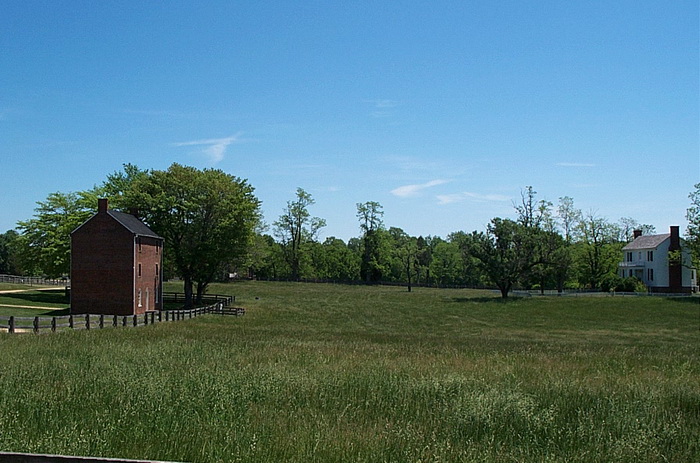 |
|
#13: Turning around on the Park's parking lane and looking
east is the Appomattox County Jail House on the left and the Bocock-Isbell House
on the right. The jail was known as the "new" jail having replaced the
"old" jail that stood opposite across the Richmond-Lynchburg Stage Road off to
the left. |
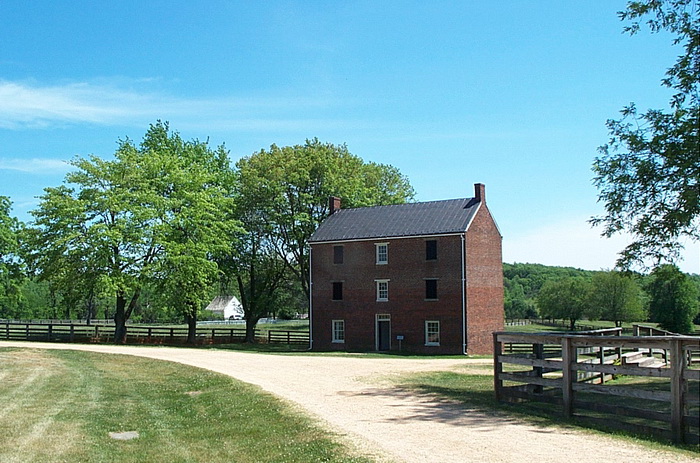 |
|
#14: This is the front of the "new" Appomattox County Jail
House with the Bocock-Isbell House just off to the left. The fence on the
right marks the circular loop that encloses the Court House. The Clover
Hill Tavern complex is directly behind the camera so we have completed the loop
and will he heading east, to the left on the Richmond-Lynchburg Stage Road. |
 |
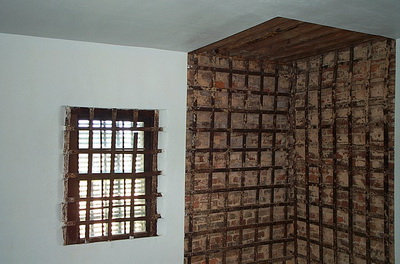 |
|
#15: The interior of the Jail House has two reconstructed
rooms. This one shows the probable contents of one of the jail rooms.
More than likely, the beds were possibly "bunked" so that four prisoners could
be housed per room if need be. |
#16: This room shows the construction of the iron
cross-member lattice that was built between the outer brick wall and the inner
plaster wall. Obviously, the iron prevented escape. |
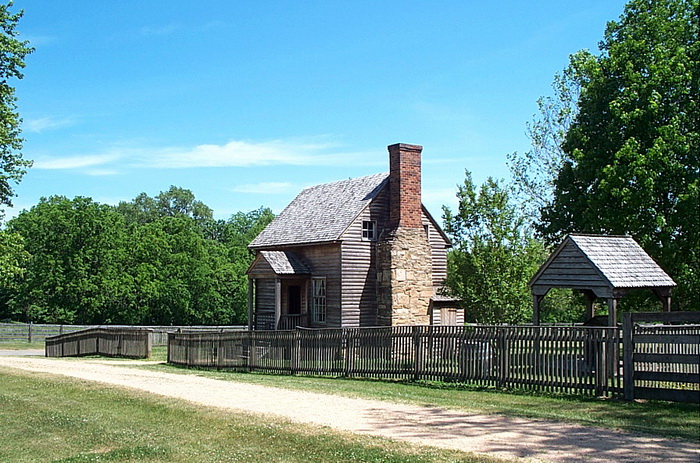 |
|
#17: Continuing east along the Stage Road, which bends to
the left, is a short lane shown here which intersects the Prince Edward Court
House Road at the fence line. That road intersects the Richmond-Lynchburg
State Road off to the right where we will be in a moment. The small
building is the Jones Law Office with a covered well. |
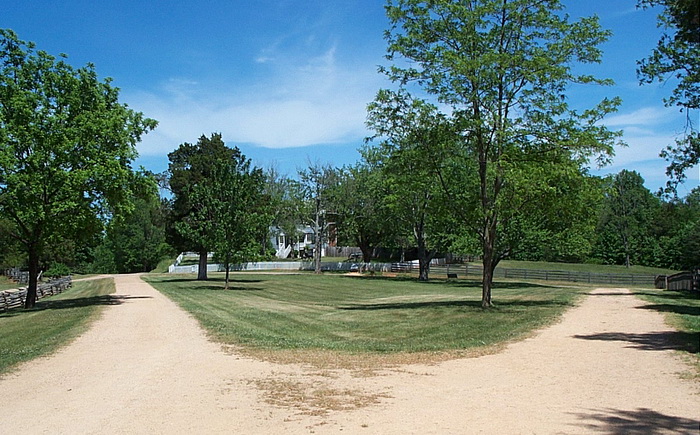 |
|
#18: This photo was taken looking east at the spot were
the Richmond-Lynchburg Stage Road veers off to the left, the Jones Law Office
lane to the right, the Prince Edward Court House Road merges with the Stage Road
just to the left of the Peers House, and Bocock Lane joins the Stage Road/Jones
lane crossroad just off camera to the right. |
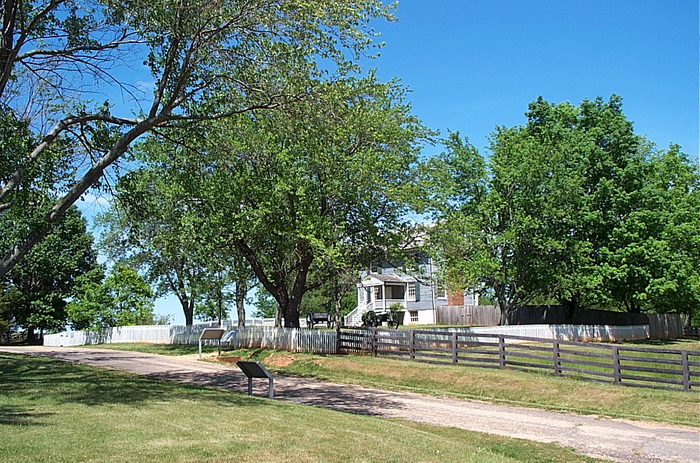 |
|
#19: This is the Peers House at the intersection of the
Richmond-Lynchburg Stage Road and the Prince Edward Court House Road. The
house was occupied by George Peers, clerk of the Appomattox Court House for 40
years. The house was built in the early 1850's but is not open to the
public. |
 |
|
#20: This close up of the Peers House front lawn shows an
artillery limber and Napoleon 12-pounder. |
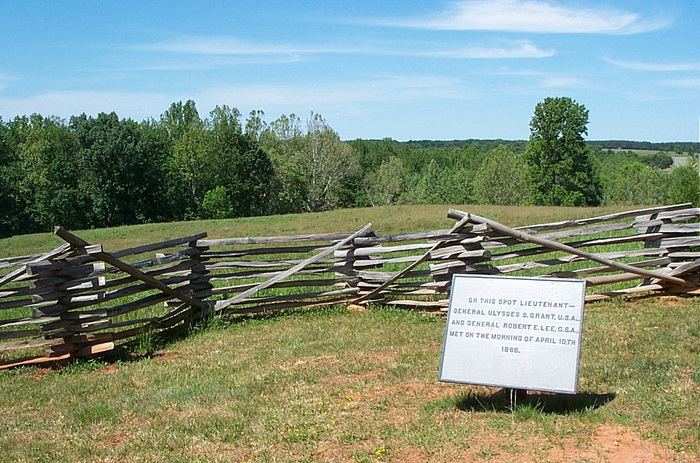 |
|
#21: Just beyond the Peers House east along the Stage Road
looking east is this spot where Lee and Grant met on 10 April 1865 and from
which all the way back into the village both sides of the Richmond-Lynchburg
Stage Road were lined with about 5000 Union troops through which Lee's Army of
Northern Virginia marched to stack arms, a typical surrender ceremony event. |
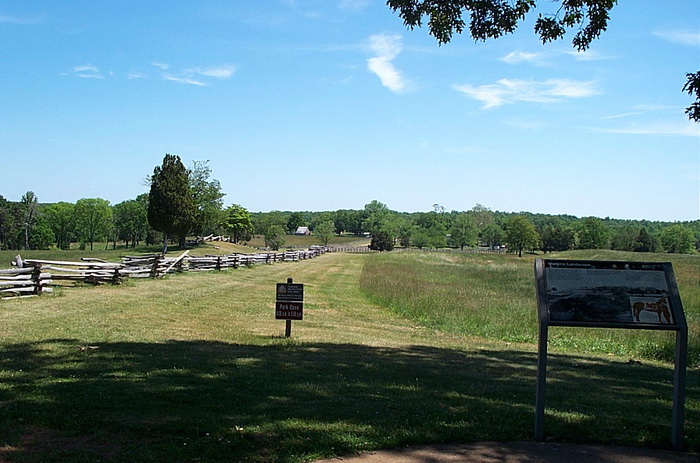 |
|
#22: Heading back to the Park's parking lot is this marker
with a period photograph showing what the village looked like in April 1865
compared to today's landscape. Back Lane is the roadway lined with
fencing. |
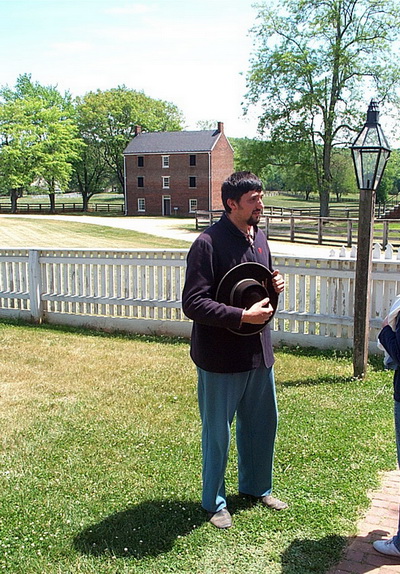 |
|
#23: During the regular season, volunteers who are usually
active re-enactor participants are available for a group talk and are almost
always "in character". Our particular interpreter represented a Union
infantry unit that remained behind after the surrender to care for wounded
brought in from the battles preceding 9 April 1865. |
I TOOK THESE PHOTOS IN MAY 2010
--------------------------------------------------------------------------------------------------------------------------
REFERENCE
Appomattox Court House,
National Historical Park, Virginia, National Park Service, U. S. Deportment of
the Interior. Contact information is: P. O. Box 218, Appomattox, VA 24522,
(434) 352-8987, website:
www.nps.gov/apco
GO TO?
© Copyright by George Grasse






















